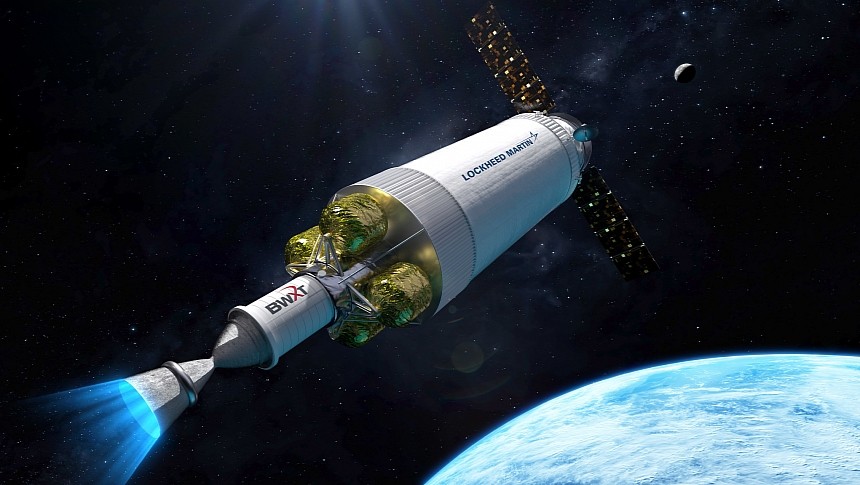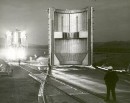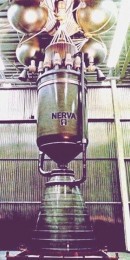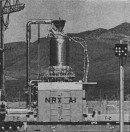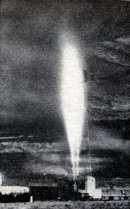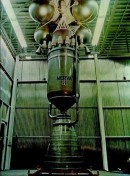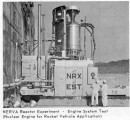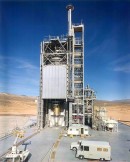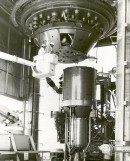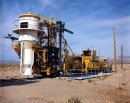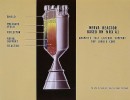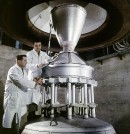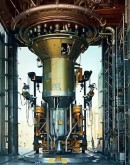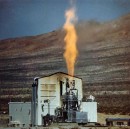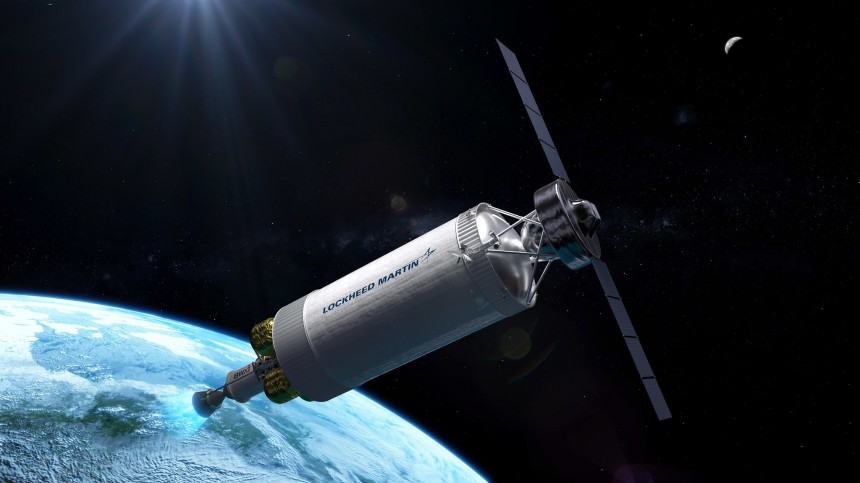Nuclear-powered spacecraft are in the domain of science fiction, right? Though theoretically fantastic for bringing humans to other heavenly bodies, we're routinely told such tech is outside the bounds of what's currently possible. At least, that's what most people are bound to tell you if you ask them about it. But forgive the uninformed masses; they probably don't know the U.S. had nuclear rocket engines almost 60 years ago. Thanks to Lockheed Martin's newly-cut deal with DARPA, we're about to have them again.
In a press release available on Lockheed Martin's news page, the company announced from its research facility in Denver, Colorado, that the company had secured a lucrative contract from the Defense Advanced Research Projects Agency (DARPA) to develop a nuclear-propelled spacecraft capable of bringing American astronauts and their allies to far-off places like Mars and the Asteroid Belt. Dubbed the Demonstration Rocket for Agile Cislunar Operations (DRACO), this project is expected to yield results not in some long-distant decade but before this current decade is even finished.
But to understand the current state of American nuclear rocket tech, we need to familiarize ourselves with how these engines work and what they used to look like. At its heart, there are two different form factors that scientists have developed to harness the power of fission for the means of propelling a spacecraft. There are nuclear-electric rockets (NERs), which use the energy of neutrons flung off from fission reactions to harness electricity to power an ion thruster, or the more familiar nuclear-thermal rocket (NTR). It's nuclear-thermal rockets, which use traditional chemical rocket fuel in conjunction with a fissile reactor core, that DARPA requested Lockheed Martin manufacture with a target deployment date no later than 2027.
"These more powerful and efficient nuclear thermal propulsion systems can provide faster transit times between destinations. Reducing transit time is vital for human missions to Mars to limit a crew's exposure to radiation," declared Kirk Shireman, vice president of Lunar Exploration Campaigns at Lockheed Martin Space. "This is a prime technology that can be used to transport humans and materials to the Moon. A safe, reusable nuclear tug spacecraft would revolutionize cislunar operations. With more speed, agility, and maneuverability, nuclear thermal propulsion also has many national security applications for cislunar space."
Theoretically, only needing a handful of moving parts, nuclear-thermal rockets can provide a power-to-weight ratio and overall fuel economy that makes the best pure-chemical rockets in service today. By running typical rocket fuel like cryogenic hydrogen through small channels grooved into the rocket's graphite-moderated nuclear core, the result is a rocket that can shed months off the trip to high-priority destinations like Mars. It sounds like science fiction, even in 2023. But in fact, humanity designed and built its first spacecraft-rated nuclear-thermal rocket over 60 years ago.
Dubbed the Nuclear Engine for Rocket Vehicle Application (NERVA), the first nuclear-thermal rocket ever tested was the brainchild of the Los Alamos National Laboratory, the same team instrumental in the manufacturing of the world's first combat-ready nuclear weapons deployed over Japan during the end of World War II. Built-in collaboration with key names in rocketry like Westinghouse and Rocketdyne, the NERVA rocket pumped out 246,663 newtons (55,452 lbf) of propulsive thrust with a specific impulse of 710 seconds (7.0 km/s) in its most successful test runs from 1964 to 1973. In the end, it was the administration of Richard Nixon who, along with the entire Apollo program, axed the NERVA rocket in the early 1970s to focus on problems closer to home.
In principle, the nuclear-thermal rocket being developed by Lockheed Martin currently will operate very similarly to how NERVA once did. But while NERVA only had the benefit of mid-1960s technology and a decade or two of nuclear energy research, the DRACO project will benefit from the latest and greatest in high-tech sensors, computer-assisted subsystems, and over seven decades of research to formulate the perfect NTR for each application. Unlike NERVA, which utilized a fairly standard isotope of uranium-235 to power itself, DRACO will use a special What is High-Assay Low-Enriched Uranium (HALEU) enriched up to 20 percent but can be as low as five percent.
This particularly energy-efficient HALEU form of uranium-238 allows for a far more controllable and predictable release of nuclear thermal power than what could have been achieved in the 1960s and 70s. With help from the nuclear component manufacturer BWXT Technologies of Lynchburg, Virginia, Lockheed Martin hopes to have a nuclear fission reactor, plus the highly labor-intensive HALEU fissile fuel, ready in waiting for DRACO's first round of field testing sometime before the 2020s are finished, as was the game plan laid out by BWXT Advanced Technologies LLC's president Joe Miller.
"In the past several years, BWXT has been maturing its nuclear thermal propulsion fuel and design, and we are excited to further expand into space with our ability to deliver nuclear products and capabilities to the U.S. Government," Miller explained in a Lockheed Martin press release. "We look forward to building the reactor and manufacturing the fuel at our Lynchburg, Virginia, facilities." As for Lockheed Martin's end of the operation, the spacecraft itself, details appear to be scarce for the moment. At least from computer-generated images provided by LM, their new nuclear spacecraft doesn't appear to have much visually in common with their current Orion Multi-Purpose Crew Vehicle.
But beyond just superficial appearances, expect a wide degree of commonality between DRACO and Orion in key areas like the spacecraft's interior. It won't be a surprise if the airliner-inspired, full-glass cockpit developed for the Orion crew capsule finds its way onto DRACO in some way. Furthermore, Orion's integrated suite of crew-interface technology trialed on the recent Artemis I mission, dubbed Callisto, makes its way onto Lockheed Martin's novel nuclear spacecraft in the near future. With creature comforts like Amazon's Alexa and the Webex video tool from Cisco on offer, it makes perfect sense that, if there is any component commonality between DRACO and Orion, this would be the prime candidate.
But that brings us to the real meat and potatoes of the DRACO project. Can the program really leap off the drawing board and into our mortal reality, ready for testing, before the target date for its first orbital test sometime before the end of 2027, or possibly even earlier? By the typical development timeframes of even the most ambitious aerospace companies like SpaceX, this seems like quite a tall order. But with such ambitions laid out in an official press release capacity, it's at least an indicator that one of America's most experienced and historic aerospace contractors is committed to getting the job done. This alone is exciting to no end.
But to understand the current state of American nuclear rocket tech, we need to familiarize ourselves with how these engines work and what they used to look like. At its heart, there are two different form factors that scientists have developed to harness the power of fission for the means of propelling a spacecraft. There are nuclear-electric rockets (NERs), which use the energy of neutrons flung off from fission reactions to harness electricity to power an ion thruster, or the more familiar nuclear-thermal rocket (NTR). It's nuclear-thermal rockets, which use traditional chemical rocket fuel in conjunction with a fissile reactor core, that DARPA requested Lockheed Martin manufacture with a target deployment date no later than 2027.
"These more powerful and efficient nuclear thermal propulsion systems can provide faster transit times between destinations. Reducing transit time is vital for human missions to Mars to limit a crew's exposure to radiation," declared Kirk Shireman, vice president of Lunar Exploration Campaigns at Lockheed Martin Space. "This is a prime technology that can be used to transport humans and materials to the Moon. A safe, reusable nuclear tug spacecraft would revolutionize cislunar operations. With more speed, agility, and maneuverability, nuclear thermal propulsion also has many national security applications for cislunar space."
Theoretically, only needing a handful of moving parts, nuclear-thermal rockets can provide a power-to-weight ratio and overall fuel economy that makes the best pure-chemical rockets in service today. By running typical rocket fuel like cryogenic hydrogen through small channels grooved into the rocket's graphite-moderated nuclear core, the result is a rocket that can shed months off the trip to high-priority destinations like Mars. It sounds like science fiction, even in 2023. But in fact, humanity designed and built its first spacecraft-rated nuclear-thermal rocket over 60 years ago.
In principle, the nuclear-thermal rocket being developed by Lockheed Martin currently will operate very similarly to how NERVA once did. But while NERVA only had the benefit of mid-1960s technology and a decade or two of nuclear energy research, the DRACO project will benefit from the latest and greatest in high-tech sensors, computer-assisted subsystems, and over seven decades of research to formulate the perfect NTR for each application. Unlike NERVA, which utilized a fairly standard isotope of uranium-235 to power itself, DRACO will use a special What is High-Assay Low-Enriched Uranium (HALEU) enriched up to 20 percent but can be as low as five percent.
This particularly energy-efficient HALEU form of uranium-238 allows for a far more controllable and predictable release of nuclear thermal power than what could have been achieved in the 1960s and 70s. With help from the nuclear component manufacturer BWXT Technologies of Lynchburg, Virginia, Lockheed Martin hopes to have a nuclear fission reactor, plus the highly labor-intensive HALEU fissile fuel, ready in waiting for DRACO's first round of field testing sometime before the 2020s are finished, as was the game plan laid out by BWXT Advanced Technologies LLC's president Joe Miller.
"In the past several years, BWXT has been maturing its nuclear thermal propulsion fuel and design, and we are excited to further expand into space with our ability to deliver nuclear products and capabilities to the U.S. Government," Miller explained in a Lockheed Martin press release. "We look forward to building the reactor and manufacturing the fuel at our Lynchburg, Virginia, facilities." As for Lockheed Martin's end of the operation, the spacecraft itself, details appear to be scarce for the moment. At least from computer-generated images provided by LM, their new nuclear spacecraft doesn't appear to have much visually in common with their current Orion Multi-Purpose Crew Vehicle.
But that brings us to the real meat and potatoes of the DRACO project. Can the program really leap off the drawing board and into our mortal reality, ready for testing, before the target date for its first orbital test sometime before the end of 2027, or possibly even earlier? By the typical development timeframes of even the most ambitious aerospace companies like SpaceX, this seems like quite a tall order. But with such ambitions laid out in an official press release capacity, it's at least an indicator that one of America's most experienced and historic aerospace contractors is committed to getting the job done. This alone is exciting to no end.
